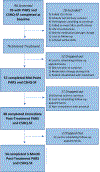The Impact of Cognitive Behavioral Therapy on Sleep Problems in Autistic Children with Co-occurring Anxiety
- PMID: 38557905
- PMCID: PMC12206321
- DOI: 10.1007/s10803-024-06309-2
The Impact of Cognitive Behavioral Therapy on Sleep Problems in Autistic Children with Co-occurring Anxiety
Abstract
Purpose: This study seeks to examine the relationship between anxiety-symptom severity and sleep behaviors in autistic children receiving cognitive behavioral therapy (CBT).
Methods: We conducted a secondary-data analysis from a sample of 93 autistic youth, 4 to 14 years, participating in 24 weeks of CBT. Clinicians completed the Pediatric Anxiety Rating Scale (PARS) and parents completed the Children's Sleep Habits Questionnaire, Abbreviated/Short Form (CSHQ-SF) at baseline, mid-treatment, post-treatment and 3 months post-treatment. Mediation analysis evaluated the role of anxiety symptoms in mediating the effect of time in treatment on sleep.
Results: There was a negative association between time in treatment and scores on the CSHQ-SF (b = - 3.23, SE = 0.493, t = - 6.553, p < 0.001). Increased time in treatment was associated with decreased anxiety (b = - 4.66, SE = 0.405, t = - 11.507, p < 0.001), and anxiety symptoms decreased with CSHQ-SF scores (b = 0.322, SE = 0.112, t = 2.869, p = 0.005). The indirect effect of time in treatment on CSHQ-SF scores through PARS reduction was negative, but not statistically significant.
Conclusion: Increased time in CBT was associated with decreased anxiety severity and improved sleep behaviors. Reductions in anxiety symptoms may mediate improvements in sleep problems, but larger sample sizes are necessary to explore this further.
Keywords: Anxiety; Autism; Children; Sleep; Treatment.
© 2024. The Author(s), under exclusive licence to Springer Science+Business Media, LLC, part of Springer Nature.
Conflict of interest statement
Dr. Storch reports receiving research funding to his institution from the Ream Foundation, International OCD Foundation, and NIH. He was formerly a consultant for Brainsway and Biohaven Pharmaceuticals in the past 12 months. He owns stock less than $5000 in NView. He receives book royalties from Elsevier, Wiley, Oxford, American Psychological Association, Guildford, Springer, Routledge, and Jessica Kingsley.
Figures


References
-
- Bates D, Maechler M, Bolker B, Walker S. (2015). Fitting Linear Mixed-Effects Models Using lme4. Journal of Statistical Software, 67(1), 1–48. doi: 10.18637/jss.v067.i01. - DOI
-
- Beran TN (2007). Elliott CD. (2007). Differential Ability Scales (2nd ed.). San Antonio, TX: Harcourt Assessment. Canadian Journal of School Psychology, 22(1), 128–132. 10.1177/0829573507302967 - DOI
-
- Boedeker P. (2017). Hierarchical linear modeling with maximum likelihood, restricted maximum likelihood, and fully Bayesian estimation. Practical Assessment, Research and Evaluation, 22. 1–19.
Grants and funding
LinkOut - more resources
Full Text Sources
Miscellaneous

